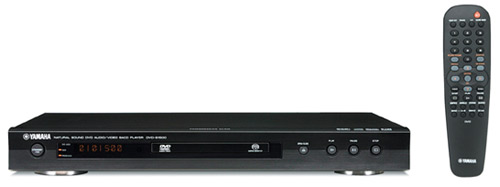

UPDATES:
August 10, 2005 - An astute reader caught an error in my description of the S1500's bass management. While the European version of the manual (the one that first appeared online, and that I made the most use of while writing this review) suggests that DVD-Audio playback does include bass management, the US manual includes a note that DVD-Audio playback automatically assumes all speakers "large" and the sub "on" (thereby bypassing all bass management). I've revised the DVD-Audio/SACD paragraph of the "Audio" section to reflect this.
June 8, 2005 - I've added a few comments under the video section regarding the S1500's user interface and video performance as compared to the OPPO Digital OPDV971H that I recently added to the system (see my review of the OPPO here).
November 26, 2004 - There are now some notes in the video section regarding s-video performance.
October 7, 2004 - I've added a note at the end of the video section with some results from Secrets of Home Theater and High Fidelity's DVD Player Shootout.
This is definitely becoming a habit. It's been a little more than two years since I retired my Panasonic DVD-A310 DVD player in favor of a Panasonic DVD-RA60 player, replacing the (at the time) three and a half year old second-generation player with a model that offered better compatibility with complex discs and support for DVD-Audio. When I made that upgrade, I wrote a review of the RA60 and posted it on my website, where it joined the newly-arrived review of Outlaw Audio's Model 950 pre/pro. Two years later, I'm writing the eleventh equipment review to appear on my little site, and it's another DVD player (the fourth, counting the DMR-E80 DVD recorder). As in previous reviews, I've included an equipment list for my system at the end of this review as a reference.
The RA60 has been a good player, but it was always intended as a transitional unit – something to tide me over until I would need progressive scan video and until decent, affordable universal (DVD/DVD-Audio/SACD) players were available. The last couple of years have seen a lot of progress in the realm of universal players, but I didn't see anything that struck me as the right combination of features, performance, and price until late 2003. The first candidate was the Pioneer DV-563A, which at under $200 retail ($250 MSRP) is still the least expensive universal player worth considering, but I was wary of the video performance and flexibility of a universal player at that price. I didn't want to upgrade from the RA60 until I found a player that would be a true step up across the board, not simply a player that would add a feature or two. Then Denon revamped their line-up with a trio of universal players starting in the stratophere (the DVD-5900 for $2000) and working down from there (the DVD-2900 at $1000 and the DVD-2200 at $630). The 5900 was a flagship sort of product, with DENON Link digital output for DVD-Audio (compatible with their flagship receiver, the AVR-5803, only), FireWire, DVI-HDCP, Burr-Brown DACs, Faroudja DCDi decoding, and all the bells and whistles they could squeeze in; it is in the process of being replaced by the DVD-5910 and the less expensive DVD-3910. The 2900 dropped many of the biggest features of the 5900 (DENON Link, FireWire, DVI) and traded the Faroudja for a Silicon Image/DVDO chipset, and the 2200 lost the Burr-Brown DACs and had half as much cache memory (4MB in lieu of 8MB). The DVD-2200 immediately became my leading candidate for a universal player; although the price was a stretch and it was essentially the bare bones version of its larger siblings, it offered the features I was looking for and the potential for a step up in performance from the RA60. Finally, CES 2004 brought one small announcement among all the other news: a new universal player from Yamaha with Faroudja DCDi progressive scan decoding, 12-bit/108-MHz video DAC's, DVD-Audio and SACD support, upconverting of CD audio from 44.1kHz to 176.4kHz, and MP3 support that supposedly included better playback features and navigation than past players. Outputs included component video, s-video, composite video, analog stereo, analog multi-channel, digital coaxial, and digital optical. At a $400 list price, the S1500 looked to be exactly what I had been waiting for. When announced in January 2004, it was reportedly due to be available in March 2004. That gave me time to set aside money for the player and recover from the move into our new house. Once March rolled around, I started contacting my local Yamaha dealer and checking a few online sources. Not surprisingly, the March release date slid right through April and May, by which time my venerable old Mitsubishi 27" TV was retired and a 32" HDTV set in its place its place, making progressive scan support that much more desirable. The summer ended up being dedicated to an absurd series of kitchen renovation delays, quietly paralleled by the ongoing delays for the S1500 – Yamaha's site continued to show the DVD-S1500 as available in May 2004, but the user manual was missing from their site (although it did appear on at least one of Yamaha's European sites around early June) and dealers remained unsure when to expect the first shipments. I called my dealer in mid-September for a schedule update, and at that time he was hoping to get the first shipment in by the end of the month. Surprisingly, the first units showed up on his doorstep about two days later, and I picked mine up at lunch on the day they arrived.
The Yamaha DVD-S1500 is a very different product from players like the Panasonic DVD-S35 that I reviewed last year, even though its slim profile is reminscent of the S35 and other super-thin players. The list price and feature set clearly separate it from the entry-level swarm of players that have flooded the market in the last couple years. The build quality should likewise exhibit some improvements over what could be found in a $80 player from Best Buy or Sears.
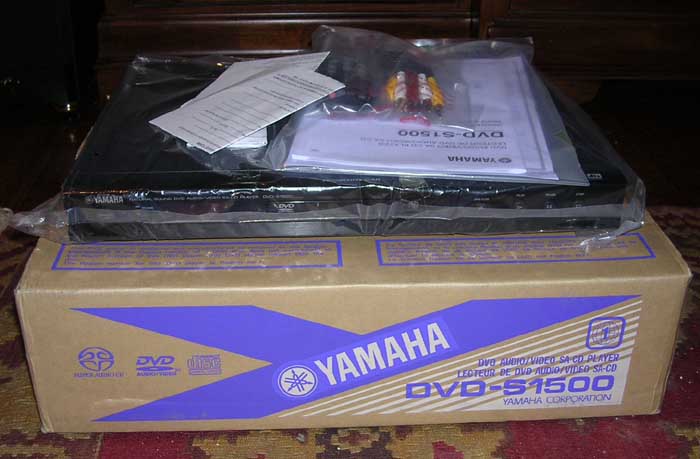

The S1500's remote is a far cry from the large, complicated looking behemoth that came with my Panasonic A310 back in 1998. It is relatively comfortable in the hand and reasonable in size (unlike some of the recent Panasonic remotes that look like they were designed and then scaled down about 15%). There's no backlight or glowing buttons, which may be an issue for some users, but since I will be using my unviersal remote for everything that didn't upset me. There were a few issues that I soon found with the remote, however. First, there are no dedicated fast forward and rewind buttons. You can hold down the skip forward/back buttons for about two seconds to start fast forwarding or rewinding, but I would have preferred separate buttons. Second, the bottom navigation key can be easily mixed up with the transport keys – once you start fast forwarding or rewinding, you have to press PLAY to resume normal play, and I kept shifting directly over from the skip buttons to the down navigation key and expecting it to be the PLAY button. Overall, it's not a terrible remote, but it could have been better.
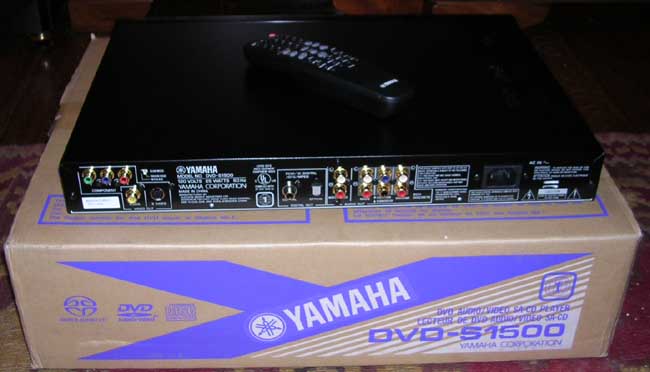
Since the S1500 is replacing a DVD-Audio player, most of the cabling was already in place, a good thing considering the cramped quarters for cabling inside the new entertainment center. The power cord is an IEC type, so the RA60's cable couldn't be re-used. The half-dozen Outlaw Audio PCA analog audio cables moved directly over from RA60 to S1500, as did the PSSV S-video cable and PDO optical digital audio cable. The Blue Jeans Cables component video cables that were added when the 32" HDTV arrived shifted over as well. I added a coaxial digital audio cable in order to compare the two interfaces (a Blue Jeans Cable coaxial digital that I picked up when I ordered component video cables for the HDTV, although I may eventually replace it with a 0.5 meter Outlaw PSC), and the connections were complete.

Hookup of all of this mess went pretty smoothly. The six channel analog output is fairly logically laid out – my assumptions of which ports went with with channels were accurate even when peering over the top of a pile of equipment with my head inside a cramped cabinet. The optical port is of the style I prefer, with an integral dust cover door instead of the old removeable plastic cap. The RA60 will eventually be removed from the system entirely, but I initially shifted it up to the top shelf and connected via optical digital audio and s-video so I could experiment with some brief interlaced DVD comparison testing if time permits.
The remote is a bit different from many DVD player remotes in that it seems fiercely determined not to be overly complicated. This makes basic operation fairly straightforward and somewhat simplifies integration of the remote with my MX-500 universal remote. The previously mentioned lack of fast forward and rewind buttons remained an irritant here, but it did lead me to finally investigate a lingering question about the MX-500's learning function: when learning a function to a button, hold down the button being taught until the MX-500 is done. This will allow the MX-500 to send a continuous signal when the button is held down, which is very handy for large scale volume adjustments and is essential for making the S1500 fast forward and rewind. After learning the commands for skipping forward and back to the MX-500, I found it inordinately difficult to skip back to a previous chapter or track, as the back button tends to get stuck at re-starting the current chapter or track. It's not a problem for CD's, SACD's, or MP3's thanks to the on-screen interface that allows the navigation buttons to hop through the disc, but it is a bit of a pain with DVD's. Fortunately, I was able to use the included pre-programmed code for a Yamaha DVD player (083 for the MX-500), which seems to have resolved the problem.
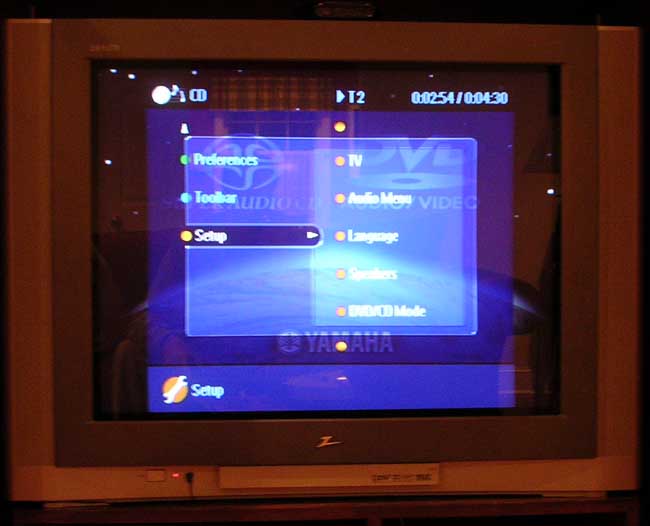
All of the menu options for the S1500 are contained in a single central menu, which is then divided into three main categories. Unlike some past players, the S1500 allows access to this menu at any time, although entering some sections will cause disc playback to pause. This is understandable, since the sections in question affect how the player's audio and video outputs behave. Also unlike nearly all of the previous players I've used, the S1500 came with the digital output enabled for all formats, including DTS (which has historically been disabled by default). With my new display (a Zenith C32V37 4:3 HDTV), there are two options for setting up the monitor shape, and while I know which I prefer I'm still evaluating both with user simplicity in mind. The optimal approach is to set the display to 16:9 under Setup and then set the 4:3 Aspect (under Preferences and Adv. Picture) to NL Stretch so that the player always outputs a 16:9 image and I can set the TV to 4:3 or 16:9 depending on the source. The other option is to set the display to 4:3 and let the player letterbox anamorphic material, which would allow the TV to always be in 4:3 mode with DVD's but would sacrifice some resolution on anamorphic widescreen material.
Note that the S1500 has one other option in its menus: NTSC and PAL support, something rarely found in a Region 1 DVD player. The US version ships with the default that is best suited for this market: the S1500 will always output an NTSC signal, automatically converting PAL video to NTSC. If you have a PAL-compatible display, you can change this.
Overall, the OSD for setup is well done, although I'm not real pleased with the mixing of playback controls with player settings in a single interface. The OSD for other interfaces such as playing audio sources (CD's, SACD's, or MP3's) is better than those I've used previously. Sadly, the front panel display is less informative than I'd like. Had Yamaha used a little more of the front panel for the display, it would have been able to offer the more typical range of information, but as it stands you can only see either the elapsed time or the title and chapter number. I'd prefer to have both, or at least the time and the track/chapter number.
There is a lot to look at here. The S1500 will play CD's, DVD-Video discs, DVD-Audio discs, SACD's, Video-CD's, and MP3's on CD-R. Dolby Digital and DTS digital output should be utterly transparent on a good DVD player, so I only checked it out enough to verify that all was well there. I was particularly interested in CD (digital and analog outputs), DVD-A, and SACD playback, although I was also curious to see how far Yamaha had gone with the MP3 playback interface and performance.
Audio performance on DVD's should not be an issue for any reasonable DVD player when feeding digital data to a processor or receiver; the player should simply pass the digital data on without altering it in any way. The S1500 includes both coaxial and optical digital outputs, which is the same arrangement that my original player (the Panasonic A310) uses. The RA60, like almost all of Panasonic's newer players, includes optical digital audio output only. Because I already had an optical cable in place, I connected the S1500 to it, but I also dug out a coaxial digital audio cable and connected it to allow me to compare the two. Past experiments had shown that it was nearly impossible to differentiate between the two formats, but having both connections on my A310 had been useful for some troubleshooting on one or two occasions. In the process of running through a few sample DVD's to look at the video, I was able to confirm that there seems to be nothing out of the ordinary with the S1500's digital audio output using both optical and coaxial outputs.
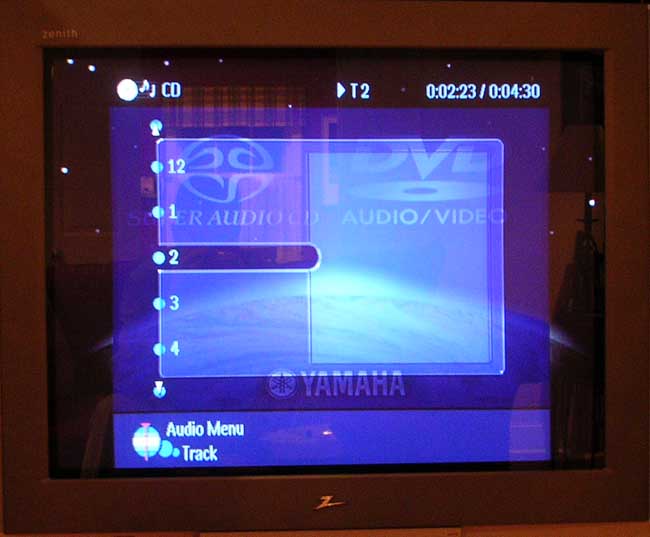
Since the DMR-E80 evicted my Yamaha CDC-775 CD changer from the old equipment rack last year, the DVD player has been doubling as CD transport as well, an arrangement that I've been pleased with. When the new entertainment center arrived, I considered bringing the changer back, but the need for a particularly long optical cable and the excellent performance I've had using the RA60 as a transport changed my mind; the CDC-775 remains tucked away in the closet. There are two options available for playing CD's with the S1500: use the digital output (either coaxial or optical) and let the Model 950 handle the digital-to-analog conversion, or use the S1500's DACs and play CD's through the 950's multichannel analog input (which is hooked up anyway for DVD-Audio and SACD). Because the S1500's DACs should be pretty substantial to handle the DVD-A and SACD material and because the S1500 upconverts digital CD audio sampling rate to 176.4Hz (a nifty trick that I was curious about), the second option seemed most likely to please me. Before we discuss the audio performance on CD's, however, I want to take a moment to touch on the interface. With a video display to work with, it would seem logical for all DVD player manufacturers to include some sort of on-screen disc interface. It would be an ideal case for CD-text support, something that is already fairly standard on jukebox megachangers. Granted, many DVD-Audio and SACD players include the option to disable the players' video circuits to reduce the potential for noise entering the audio output signal, but it would be worthwhile to toss in a simple on-screen display and CD text compability for those who wanted to use it. Instead, DVD players have historically done no more than toss up a blank screen and list (at most) the track number. It seems that perhaps someone at Yamaha feels similarly. The S1500's interface for CD playback is the same basic one used for other audio-only formats, and it is a step up from the interface found on the players I've previously used. The left side of the screen lists the tracks, and you can use the number pad to jump to a track or use the navigation pad to scroll through them. The right side of the screen offers CD text information if it is available, although most discs will simply be blank. What about the sound? When used as a CD transport feeding PCM digital audio to the Model 950, the S1500 performed as well as the RA60 did before it. I'm still trying to decide if I like the S1500's analog output stage as much as I like the 950's DACs, but my initial impression was that I preferred the 950's DACs. That impression was made before realizing that the S1500 was applying Pro Logic II processing to the signal. When revisiting the issue, I found that using the stereo analog outputs with the 950 in bypass mode yielded a much better sound. In fact, I seem to be finding the sound to be a bit cleaner this way than when using the 950's DAC's. I'll probably use both methods for the time being.
Bass management for DVD-Audio and SACD has long been a problem, as even standalone DVD-Audio or SACD players have often lacked any sort of bass management. In my system, I rely on the Model 950's six channel input (and the 80Hz analog crossovers on that input) for bass management of DVD-Audio and SACD. The Yamaha does offer bass management for the Dolby Digital, Dolby Pro Logic II, and DTS decoding (all using a fixed but undocumented crossover point). It also offers bass management for SACD. The SACD bass management is configured independently (in the "SACD Mode" section of the menu) and will only work if the SACD Direct setting is changed to OFF, at which point a separate section of the speaker setup menu allows for SACD speaker size settings and subwoofer crossover point (the default crossover point is 120Hz, but 60Hz, 80Hz, and 100Hz are also options). That just leaves DVD-Audio, which I initially believed benefitted from the same bass management provided for Dolby Digital, Pro Logic II, and DTS. Unfortunately, the US user's manual offers a tidbit of highly useful information that was left out of the European manual: DVD-Audio playback will always assume all speakers are set to "large" and the sub is set to "on" – which is a long-winded way of saying "we have no bass management on DVD-Audio." In my system, I disabled the bass management by leaving all speakers set to "large," the sub to "on," and SACD Direct set "on" to disregard the SACD Mode options. During my initial setup session, I briefly played both the DVD-Audio and SACD versions of 3 Doors Down's second album Away from the Sun and was pleased with the results. Additionally, I've begun delving into SACD and re-visiting several DVD-Audio titles that I was already familiar with. The DVD-A discs that I already knew sound just as good as I remembered them, including the always entertaining Audio from Blue Man Group and Away from the Sun. I'm going to have to do some more extensive listening to decide if I have a favorite format – several of the SACD's I have are older albums in stereo SACD only, which can help show the benefits of the SACD format over CD (as well as highlight any old imperfections in the recordings even better than a good CD could). So far, I'm coming down slightly in favor of DVD-Audio, due in part to the titles I have in my small library.
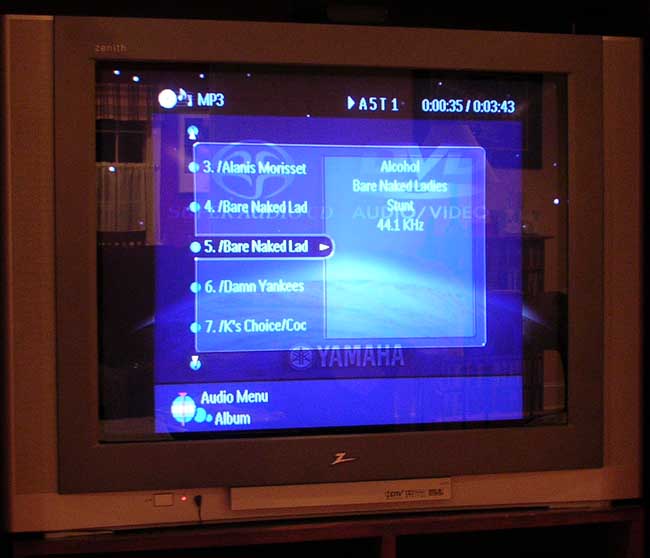
I first remember friends ripping MP3's of their CD's back around 1997 or 1998. Beginning around late 1998, I started doing this myself so I could listen to music at my desk at work, so I've got several CD-R's around the house with MP3 archives of some of my favorite CD's. I've remarked once or twice about the tendency for DVD player MP3 support to be a bit on the anemic side – even when the audio performance is respectable, the interface is marginal at best. The press release that announced the S1500 mentioned "special playback functions and MP3 navigation display" when describing the S1500's MP3 support – hints of a newer, better MP3 interface under the hood. The S1500's MP3 interface may not be my "ideal," and it does have a quirk or two when using discs containing both JPGs and MP3s (you can access one type or the other, but so far the only way I've found to access one and then switch to the other is to eject the disc or power off the player), but overall it is clearly a step up from the units I'd seen previously. Not only is there a less bland "blue screen" background, but more importantly there is effective support for ID3 tags. Similar to the CD and SACD interface, the left side of the screen displays the file and folder structure for the current folder, with the active file or folder highlighted in the center of the list. The right side of the screen is a window displaying information about the current file: artist, album, and title from the ID3 tag and the resolution at which the file was encoded (typically 44.1kHz, although I did have a few 22kHz files rattling around one disc that I tried). The manual mentions that the player may require several seconds (10 seconds or more) to fully scan the disc before allowing playback. The amount of time required will vary depending on how many files are on the disc. As with most other DVD players, MP3 playback quality is good, but the capabilities of a good home theater system are sometimes painfully capable of highlighting the flaws in overly compressed or low resolution MP3's. I did also encounter one compatibility issue: as with the Yamaha CDC-775 CD changer that I used before, the S1500 will not recognize some Imation CD-R's. Other brands of CD-R's do not pose a problem.
Overall, the S1500's audio side is quite respectable. I'm still getting familiar with the performance of DVD-Audio and SACD playback, but initial listening tests have been pleasing. So far, I have not found an easy way to use the onboard DAC's for CD playback while having the player set up for multichannel playback of SACD's. Fortunately, however, the player's chops as a pure transport for CD's and MP3's (as well as DVD-Video, of course) are up to par and the 950 does a good job for me on the digital to analog conversion. Obviously, there will be differences to what the S1500 can do and what a player like the Denon DVD-2910 (or presumably the Yamaha DVD-2500 that is slated to replace the DVD-2300 as their $1000 range universal player), but the S1500 still does a very respectable job with all of the formats it supports.
In the winter of 2004, the Denon DVD-2200 and the announcement at CES of the Yamaha DVD-S1500 convinced me to begin seriously considering a universal DVD player to replace the RA60. At that time, I was still operating with a standard definition TV (27" Mitsubishi direct view with s-video input). An upgrade to an HD-capable set was on the agenda, but only after a new entertainment center and some research. As a result, I initially expected to be using a universal player with a standard definition display for at least a couple months and perhaps as long as a year, in which case any review of the player's video section would focus on the S1500's performance in interlaced mode only (useful to owners of standard definition TV's, but not so much so for the HDTV crowd). That all changed when we found an entertainment center in March, the S1500's release slipped, and our tax return turned out to be large enough to cover a 32" 4:3 HD set. As a result, there was already an HD display in place when the S1500 arrived. I also kept the RA60 around briefly to compare the two directly, looking at interlaced performance over s-video.
The S1500 includes a wide range of playback features. There are the usual repeat modes (A-B repeat, chapter repeat), which are convenient but rarely used. It can offer access to JPG files stored in CD-R's, including the ability to scroll through them in an automatic slideshow. The S1500 also includes a zoom function (1x, 2x, 4x, or 8x) – the first time I've had a DVD player in my main system that offered zoom, since Panasonic has historically not included zoom on their players. As with the repeat modes and JPG slideshows, I don't know that I'll ever have much need for it, but it's sort of neat to have it available. Slow motion forward and reverse playback is an option, but unlike my Panasonic players (which use the fast forward and rewind buttons to control slow motion when pause is enabled) you must enter the onscreen menu's "Toolbar" section (which covers the entire screen with a semi-translucent menu) to enable slow motion playback and the change the speed of that playback. The S1500 is listed as being compatible with DVD-R but not DVD-RAM, something which I was able to confirm. It readily recognizes and plays DVD-R's recorded and finalized by my DMR-E80, but it ejects DVD-RAM discs. While reviewing a sample set of bonus discs for a Star Wars bootleg in late November 2004, I had an opportunity to try some DVD+R media. These DVD+R discs would not work at all in my PC's DVD-ROM drive, but the S1500 handled them flawlessly.
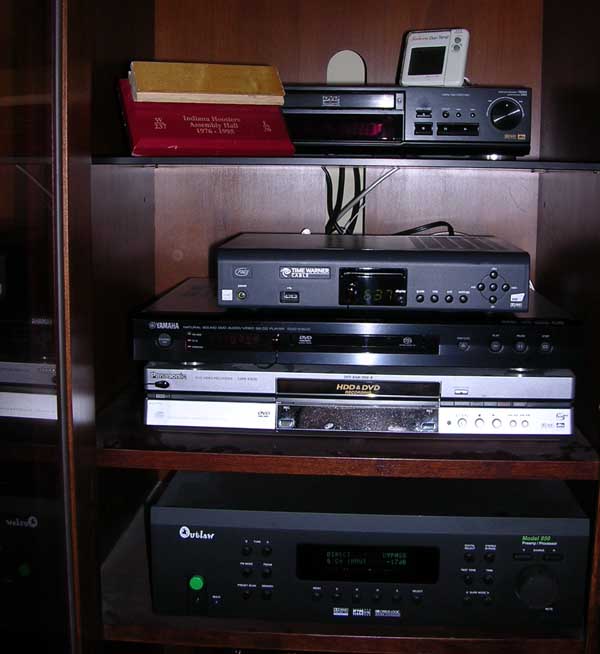
I tossed an assortment of material at the S1500 to test its video performance. Several discs that had been clean and moderately detailed on the RA60 immediately revealed greater image detail with the S1500. I tried several animation discs that I'd briefly looked at before with the RA60 and the new TV. The color and detail in Princess Mononoke had been very good on the RA60, but the S1500 brought out additional fine detail that I didn't remember seeing before. The odd little animated short "Voices of a Distant Star" (an anime-style story similar to classic science fiction tales like Robert A. Heinlein's Time for the Stars) had a definite improvement in detail with the S1500. I'd noticed some odd pixel crawl on the windows of highrise buildings during panning city views in Akira when using the RA60, but I could find no such artifacts with the S1500. Attack of the Clones was my first choice for looking at a good transfer of live action, and the picture produced by the S1500 was the first time I've seen DVD actually begin to rival true HD content – it was a clear step up from the RA60. Out of curiousity, I made sure the DMR-E80 was set up for progressive scan output and tried it with some of the same scenes in Attack of the Clones and found much of that newfound sense of clarity and transparency missing. Clearly, the S1500 can do some fabulous stuff when given a great transfer, likely due at least in part to the Faroudja DCDi processing. On the other hand, poor transfers can only be made to look so good, and when experimenting with 4:3 aspect ratio material (season six of Buffy the Vampire Slayer), the limitations of a softer and grainier transfer were revealed. While the material didn't look bad, it also clearly lacked the clarity and detail of a better transfer – and the difference between the two was more pronounced than I had ever achieved in my system. Likewise, other video sources such as DVD-R's transferred from VHS and S-VHS originals fare only as well as they can be expected to, offering video that is clearly from a low resolution analog source. Moving back to commercial discs, I used Attack of the Clones to test the layer change speed (the layer change occurs a few seconds into chapter 28, at 1:06:28). While I could spot it because I was looking for it, the change took easily half the time normally required by my RA60 – it was as close to an "invisible" layer change as I've ever seen. There are a few more things that I want to investigate – including next week's new Star Wars set of course – but overall the S1500's video performance has been very pleasing.
Update, 11/26/2004: After having an opportunity to fix some loose connections behind the TV while installing a pair of monoblock amps, I was able to conduct a brief comparison between the s-video performance of the S1500 and my old Panasonic DVD-RA60. There's not a lot to report here, as the two both offered comparable performance. Small object detail was not as good as over component video and in a couples of cases I noticed some jitter on both players. I'd consider the S1500's interlaced s-video performance to be pretty adequate, especially on smaller displays, but as with any DVD player it is still worthwhile to step up to component video if possible. Unlike the significant improvement seen when comparing the Yamaha's progressive scan output to the RA60's interlaced component output, there was little to no difference between the two on s-video. If anything, the RA60 might be the better player for standard definition TV's with only s-video inputs. Based on this brief test, I feel that the S1500's s-video output (and likely its composite video output as well) is not as strong as it could be – owners of HDTV's or at least sets with component video inputs will not be concerned by this, but there are still a lot of folks out there with sets that lack component inputs. For them, the S1500 still offers very good support for a range of formats and decent video quality, but it is possible that an entry-level player like the Toshiba SD-3960 might work just as well or better for general DVD-Video playback.
Update, 10/7/2004: On October 6, 2004, Secrets of Home Theater and High Fidelity added a dozen more players to their DVD Player Shootout, including the S1500. The deinterlacing section fared well, with only a single failure (2-2 pulldown, which affects PAL playback but not NTSC). Layer changes clocked in at a very respectable 0.75 seconds. The core performance was a bit disappointing, with failures in 2-2 Film and 4:2:0 ICP chroma errors, video levels, blacket than black, YC delay, image cropping, and sync subtitle to frame. Overall, it is not a great set of results, and a clear step down from the performance noted for Yamaha's more expensive DVD-S2300 universal player. This test does not focus on audio performance at all, which is certainly one of the S1500's strong points (especially at this price), and several of the failures were under conditions that many people may not encounter. European users might want to check the S1500 out before buying, since the only deinterlacing error and the 2-2 chroma error are generally going to only affect PAL material; US consumers are significantly less likely to be affected, and I am still very satisified with the S1500's progressive scan performance. Hopefully Yamaha will be able to improve performance in some of these core categories for future players in this price range and perhaps even develop a firmware fix for some of the items identified by Secrets. For an explanation of the tests used in the Secrets shootout, see this page.
Update, 6/8/2005: The biggest single gripe that I've had with the S1500 has consistently been the user interface. Minimal front panel information, cumbersome transport controls, clumsy on-screen navigation directly to select tracks or chapters, and no way to directly access specific elapsed time positions on DVD's are all issues that start out a little disappointing and evolve into steady irritants. Probably the three biggest objections have been the inability to skip back to previous tracks or chapters with multiple presses of the "|<<" button, the absence of track or chapter numbers on the front panel display, and the lack of dedicated fast forward and rewind buttons. These interface issues were part of the reason that I recently looked to an inexpensive upsampling DVD player for DVD Video duty, relegating the S1500 to serving primarily as an audio player (CD, DVD-Audio, and SACD). The OPPO Digital OPDV971H sells for $200 less than the S1500 and offers DVD-Audio support (but not SACD). The OPPO's interface addresses all of my interface concerns to at least some degree: the front panel display shows both track/chapter and time (although the title is not shown), the remote offers separate chapter skip and fast forward/rewind controls, the player settings menu is separate from transport and playback controls, and a button on the remote (labeled "GO TO") allows the user to directly jump to a specific title, chapter, or time position. The OPPO's component outputs are limited to interlaced video (480i), but its DVI output is capable of 480p, 720p, and 1080i. At 1080i on my Zenith HDTV, the OPPO can make good DVD transfers look exceptional. If the Yamaha's interface had done what it needed to, I doubt that I would have upgraded. As it stands, however, the OPPO is now my DVD player of choice, while the Yamaha provides me with a separate audio player.
A universal DVD player offers consumers a very convenient solution to the high-resolution audio format war between DVD-Audio and SACD in addition to providing a DVD-Video player. After a couple of years of high prices and spotty performance, the latest crop of players includes a range of very appealing models from several manufacturers. Many of these new players also serve to fill a niche in the DVD player market that has thinned significantly in the last year or two. Five or six years ago, all of the major manufacturers offered small but varied product lines that included entry-level models aimed at the budget-conscious consumer (the <$200 range), more sophisticated mid-level models for the audiophile and early adopters (the $400-$700 range), and in a few cases a flagship product of some sort (call it $1000+). The arrival of extremely inexpensive players from brands like Apex, distributed through channels such as Wal-Mart or Target, marked the beginning of a shift in that approach. Today, most manufacturers have shifted their focus toward the entry level, where the average consumer wants to buy; this entry level does fortunately include an array of decent players, if you are willing to weed through some of the junk. Among the crowd of sub-$100 players, there are a number of only mediocre players and very few standouts. Toshiba's budget player faired best in a crowd of entry-level players recently added to Secrets of Home Theater and High Fidelity's DVD player shootout, but an example of Panasonic's latest batch of players (slightly newer models of the DVD-S35 that I reviewed almost a year ago) were among the numerous players that performed miserably. Average users connecting these players to older TV's via composite video connections (or even RF modulators) may not care or be able to see all of the flaws, but it is sad to see such poor results. Part of the shift in focus has created two distinct groups of players at the low and high extremes of price, causing the mid-level selection to collapse. This change is perhaps most visibly represented by Panasonic's decision last year to discontinue the DVD-RP91 and DVD-RP82 without replacing them with a comparable new model. For those of us with a strong interest in the home theater and audio hobby but a budget that doesn't support players costing close to or beyond $1000, this leaves a smaller selection of players from which to choose. Instead of the Panasonic and Toshiba players that once stood near the top of our shopping lists, we are seeing companies like Denon and Yamaha becoming more prominant. I hope to see some other manufacturers join them in the coming year or two – it is a market segment that was almost inaccessible to less mainstream brands like Outlaw Audio or Rotel a couple of years ago, but is now very well suited to them. In the meanwhile, I've finally replaced my Panasonic DVD-RA60 with a universal player that does most of what I want.
The Yamaha DVD-S1500 clearly belongs in the mid-level territory of DVD players. The price tag is quite a bit higher than the $75-$150 entry level offerings, but at only $400 MSRP it is a whole lot easier to shell out for than many of the other notable universal players that typically range from $600 to $1000 or $1500. It lacks a few of the latest features such as DVI or FireWire output, both of which are just now beginning to be relevant to DVD player shopping, but it offers an otherwise very broad range of capabilities without sacrificing performance in the process. The inclusion of Faroudja DCDi is a significant selling point. The player's strong points are its video performance, good support for both high resolution audio formats, comfortable onscreen interface, and solid construction. A few user interface weaknesses keep it from being a slam-dunk – lack of dedicated fast forward and rewind buttons and an anemic front panel display – but the actual audio and video performance are quite good.